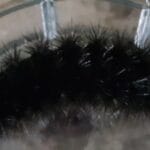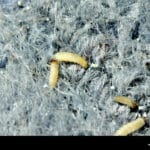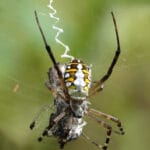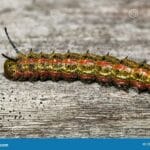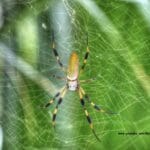White fuzzy caterpillars might appear harmless, but their appearance can be deceiving. While some are indeed innocuous, others possess venomous spines hidden beneath their soft exterior. This comprehensive guide explores the world of white fuzzy caterpillars, providing identification tips, discussing venomous species, and delving into their fascinating life cycle. Learn how to appreciate these unique creatures while staying safe.
Decoding the Fuzz: Identifying White Caterpillars
Spotting a white fuzzy caterpillar can be the start of a natural world mystery. How can you tell which kind it is? Like a nature detective, you’ll need to examine the details. The shade of white—from pure white to creamy off-white—offers a starting point. How is the fuzz arranged? Is it evenly distributed or clustered in tufts? Look closely for markings like stripes or spots. Size matters too: a tiny caterpillar likely belongs to a different species than a large one. The plant it’s munching on (its host plant) and your general location provide essential clues. These factors, taken together, can help you pinpoint the caterpillar’s identity.
Common White Fuzzy Caterpillars: A Closer Look
Let’s meet some of these fuzzy characters! The Hickory Tussock Moth Caterpillar stands out with its bright white fuzz and a bold black stripe. The Sycamore Tussock Moth Caterpillar, with its long, wispy hairs, resembles a creature draped in a fluffy shawl. The Virginian Tiger Moth Caterpillar is a bit of a wildcard, exhibiting variable coloration and long, playful-looking hairs. Knowing these common species is a great starting point for caterpillar identification.
Venomous Caterpillars: Proceed with Caution
While many white fuzzy caterpillars are harmless, some harbor a hidden danger: venomous spines beneath their fluffy exterior. Species like the Flannel Moth Caterpillar and the Hickory Tussock Moth Caterpillar can cause skin irritation, itching, and even allergic reactions. Admire them from a distance. If handling is absolutely necessary, use gloves or a stick. Ongoing research suggests the severity of reactions can vary based on individual sensitivity and the specific caterpillar species.
The Magical Metamorphosis: From Crawler to Winged Beauty
Caterpillars undergo an astonishing transformation called metamorphosis. These eating machines eventually become moths or butterflies. The caterpillar forms a chrysalis or cocoon, a protective shell where it undergoes a complete makeover. Scientists continue to study the intricacies of this process, uncovering new discoveries about this remarkable transition.
Regional Variations: Discovering Local Caterpillars
White fuzzy caterpillars inhabit diverse regions around the world. Exploring species specific to your area fosters a deeper appreciation for local biodiversity. Consider participating in citizen science projects, where your observations contribute to our collective understanding of these fascinating insects.
Debunking Myths: Unveiling the Truth About Fuzzy Caterpillars
Misconceptions abound regarding white fuzzy caterpillars. Not all fuzzy caterpillars are venomous. Large numbers don’t automatically signal an infestation. These creatures play vital ecological roles, serving as a food source for birds and other animals, and some even pollinate plants as adults. Replacing fear with knowledge allows us to appreciate their place in the natural world.
| Feature | Description | Possible Significance |
|---|---|---|
| Color | White, creamy white, sometimes with other markings | Helps distinguish different species. |
| Fuzziness | Evenly distributed, tufted, long, short | Another key identifier, possibly related to defense mechanisms. |
| Markings | Stripes, spots | Crucial for identification, can warn predators of potential toxicity. |
| Size | Varies greatly | Different species grow to different sizes. |
| Host Plant | Specific to each species | Essential for identification and understanding the caterpillar’s ecology. |
| Location | Geographic distribution | Helps narrow down the possibilities and understand regional variations. |
Our understanding of caterpillars is constantly evolving. New research and observations refine our knowledge, adding to the excitement of discovery. Continue exploring and appreciate the wonders of white fuzzy caterpillars!
Is the Sycamore Moth Caterpillar Poisonous?
The sycamore moth caterpillar, frequently sighted in the UK and Europe, can appear intimidating with its vibrant colors and fuzzy exterior. This leads many to believe it’s poisonous, which is a common misconception. While not poisonous, its hairs can cause skin irritation in some individuals, much like fiberglass. It’s a mechanical irritation from the hairs themselves, not a reaction to venom. This striking appearance, however, acts as a clever defense mechanism, mimicking the look of dangerous species to deter predators. Some people may be more sensitive to these hairs, so caution is advised. Ongoing research explores the composition of the hairs and their interaction with human skin.
| Feature | Description |
|---|---|
| Poisonous | No |
| Irritating Hairs | Yes, can cause mild skin irritation similar to fiberglass. |
| Defense Mechanism | Bright colors and hairy appearance mimic poisonous species. |
The sycamore moth caterpillar isn’t poisonous, but its hairs can irritate. Its appearance primarily serves as a deterrent. For more on the building blocks of these hairs, explore our amino acids quiz game.
Which Caterpillars Turn into White Butterflies?
White caterpillars represent the larval stage of various butterfly and moth species. Identifying them involves observing their texture, markings, and host plants. The Cabbage White caterpillar, true to its name, favors cabbages and transforms into a white butterfly. The Hickory Tussock Moth caterpillar, with its distinctive black and white tufts, becomes a moth and has irritating hairs. The Hieroglyphic Moth caterpillar, with its black and gray bands, also transforms into a moth. The journey from caterpillar to butterfly involves multiple instars, with potential color and appearance changes during each molt. While most are harmless, caution is always advised, especially with species like the Hickory Tussock Moth. Understanding regional variations and host plant preferences adds another layer to caterpillar identification.
The study of caterpillars is a dynamic field, with ongoing research continually adding to our understanding.
Are Hairy Caterpillars Poisonous in the UK?
Most hairy caterpillars in the UK are harmless, but some have irritating hairs: urticating (itchy) and stinging (venomous). Urticating hairs cause mechanical irritation, similar to splinters, like those of the Sycamore Moth caterpillar. Stinging hairs, found on the Vapourer Moth caterpillar, inject venom and can cause pain, swelling, and even allergic reactions.
| Caterpillar | Colour | Hairs | Poisonous? | Irritating? |
|---|---|---|---|---|
| Sycamore Moth | Pale green, yellow/orange hairs | Urticating | No | Yes |
| Vapourer Moth | Light green, yellow tufts | Stinging | Yes | Yes |
| Large White | Green | (Chemical defense) | No | No |
| Emperor Moth | Bright green, yellow lines | None | No | No |
| Fox Moth | Brown, white tufts | None | No | No |
Wash the affected area with soap and water after contact. Use tape to remove embedded hairs and apply antihistamine cream for itching. Seek medical advice for severe reactions. Wear protective clothing while gardening and teach children to avoid unfamiliar caterpillars. If your bearded dragon loses its appetite, it might be brumating; learn more about brumation in bearded dragons. While most UK hairy caterpillars are harmless, some exceptions exist. Ongoing research expands our knowledge of these fascinating creatures.
- Crypto Quotes’ Red Flags: Avoid Costly Mistakes - June 30, 2025
- Unlock Inspirational Crypto Quotes: Future Predictions - June 30, 2025
- Famous Bitcoin Quotes: A Deep Dive into Crypto’s History - June 30, 2025

